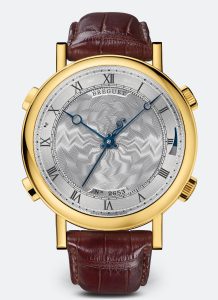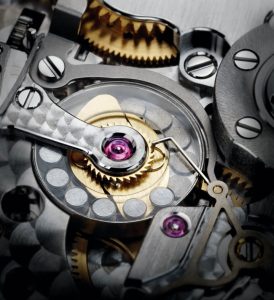Breguet
Conversation with Breguet: Réveil Musical
Wei Koh speaks to CEO Marc Hayek about technical innovation behind the Breguet Réveil Musical
At BaselWorld 2011, I was delighted to see CEO Marc Hayek injecting his singular energy and love for all things technical in Breguet, resulting in some of the most extraordinary new innovations we’ve seen in some time. In this part of our interview, we discuss the Réveil Musical.
Tell us more about the Réveil Musical…
One example of our forward-thinking is expressed by the material used in the Réveil Musical. Here, the very special caseback is made out of Liquidmetal. For many years, Apple has had the exclusivity to use Liquidmetal, but we secured the rights to use it in watches. Why Liquidmetal? Because it vibrates so much better than any other type of metal, and as a result, we can increase the volume of the sound produced by this watch by 10dB, which is a massive improvement. This is really exciting for us.
What exactly is Liquidmetal?
Liquidmetal as we use it is an amorphous titanium and zirconium alloy. It has very low dampening, and the other thing is its shaping properties. You can almost shape Liquidmetal like plastic, but it still has all the fine properties. What is very exciting is that in the future, we will be able to render precious Liquidmetal.
We have heard of some truly incredible innovations for the Réveil Musical, can you enlighten us?
The Réveil Musical is not the same watch that was first introduced last year. It has some pretty amazing innovations. The idea is that we have a disc that interacts with a comb, which plays the musical notes. This disc has a gear train that is controlled by a regulator. Now, as this watch plays a very specific piece of music by Rossini, it was very important to have a very constant tempo. For normal sonneries, you can afford to have some margin of inconsistency, but not here. We tried many different regulators, and finally, we decided on a magnetic regulator. Specifically, we use a magnetic regulator with arms in silver. It looks like a flying regulator, but the big difference is that it does not use aerodynamics or friction to slow the regulator down, but it uses magnetic attraction to regulate the speed.
Wow, that is incredible! Why is the regulator so important in a musical watch?
It is important to understand that a musical watch is different from a minute repeater or sonnerie in that you have to overcome the physical resistance caused each time the comb hits a pin. As such, it is very difficult to arrive at a nice, even tempo for this type of watches, which is, ironically, precisely what you need for the music to sound good.
Incidentally, we also did an enormous amount of research on arm profiles and materials to make sure that the sound resonating capacity was optimized. The comb is optimized to get the best tuning possibilities. In tuning, we achieved ±3Hz at 1.4kHz, which is 0.9 savart, a unit that describes the quality of tuning. It has to do with the difference between absolute tone and actual tone. Things start to sound dissonant at 1.5 savarts, so as you can see, we are quite far from this.
How do you correctly set up the regulator in terms of power of the magnets, etc.?
The principle here is very basic. It’s the balance given by the physical forces between the centrifugal force of the spring and also by the magnetic brake effect, and using this, we can calculate the current necessary for the magnetic arms to exert an influence on the regulator, which results in a very consistent tempo. This is called the Foucault Effect, named after the French physicist [Jean Bernard Léon Foucault] who worked with Abraham-Louis Breguet’s grandson, so this is a very nice part of our shared history.
Aren’t you afraid of magnetizing your escapement or your spiral?
Well, in 2006, we adopted silicon for the hairspring and the escapement, and after that, magnetism was no longer an issue.
Effectively, what is the performance of this regulator?
The duration of the melody between the first and fourth play is between 19 and 18 seconds, so you have less than 10 per cent degradation over multiple plays.
We’ve heard that you are using magnets to help maintain the position of the balance wheel pivot, is this true?
Ah, yes. Our next project involving magnetism is to use it as an ally related to the pivots of the balance wheel. It has two implications. The first is anti-shock. As you know, the entire watch industry relies on a very old anti-shock technology. So, we now have something that has all-new applications for anti-shock.
But these magnets also have tremendous possibilities with regard to improving chronometric performance. Why? Because of the friction of the pivot of the balance wheel in different positions, your timing errors are totally different when your watch is faced down, faced up and vertical. In our new design, we eliminate these differences using the power of magnetism. Using magnets, we can always ensure that the pivot is in the centre position because the power of the magnet is stronger than the very power of gravity. The pivot still touches, but only on one point at the very tip; this is totally different from a normal watch.
That is so cool, and totally in keeping with the vision of Breguet as well…
This is the perfect watch for Breguet because trying to overcome the different frictions on the pivot of the balance when the watch is in different positions was one of Abraham-Louis Breguet’s motivations for creating the tourbillon.
Condensed from an article by Wei Koh in REVOLUTION’s archives.












